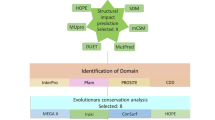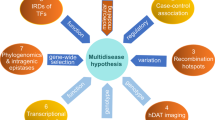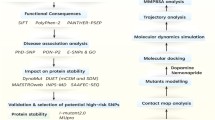Abstract
Normal function of the dopaminergic system is necessary for speech fluency. There was evidence that the activities of dopamine transporter (DAT) and dopamine D2 receptor (DRD2) could be altered in people with speech disfluency. This study aims to ascertain the possible correlation between two dopaminergic genes (SLC6A3 and DRD2) and disorder of speech fluency, and to determine the allelic frequencies of the five single-nucleotide polymorphisms (SNPs) (rs2617604, rs28364997, rs28364998 in SLC6A3 and rs6275, rs6277 in DRD2) among Han Chinese patients with this disorder. A sample of 112 patients with speech disfluency and 112 gender-matched controls were included in this case–control study. The results show that the presence of C allele at rs6277 in DRD2 gene is associated with increased susceptibility to the disorder, whereas T allele is protective. Haplotype 939T/957T is also a protective factor.
Similar content being viewed by others
Log in or create a free account to read this content
Gain free access to this article, as well as selected content from this journal and more on nature.com
or
References
Saussure, F. D. Course in General Linguistics (P. Owen, London, 1960).
Dell, G. A spreading activation theory of retrieval in language production. Psychol. Rev. 93, 283–321 (1986).
Levelt, W. Models of word production. Trends. Cogn. Sci. 3, 223–232 (1999).
Bloodstein, O. A Handbook on Stuttering (Singular Pub. Group, San Diego, California, 1997).
Costa, D. & Kroll, R. Stuttering: an update for physicians. Can. Med. Assoc. J. 162, 1849–1855 (2000).
Comings, D. E., Wu, S., Chiu, C., Ring, R. H., Gade, R., Ahn, C. et al. Polygenic inheritance of Tourette syndrome, stuttering, attention deficit hyperactivity, conduct, and oppositional defiant disorder: The additive and subtractive effect of the three dopaminergic genes-DRD2, D-beta-H, and DAT1. Am. J. Med. Genet. 67, 264–288 (1996).
Maguire, G., Riley, G., Franklin, D., Maguire, M., Nguyen, C. & Brojeni, P. Olanzapine in the treatment of developmental stuttering: a double-blind, placebo-controlled trial. Ann. Clin. Psychiatry 16, 63–67 (2004).
Maguire, G. A., Yu, B. P., Franklin, D. L. & Riley, G. D. Alleviating stuttering with pharmacological interventions. Expert Opin. Pharmacother. 5, 1565–1571 (2004).
Wu, J. C., Maguire, G., Riley, G., Lee, A., Keator, D., Tang, C. et al. Increased dopamine activity associated with stuttering. Neuroreport 8, 767–770 (1997).
Goberman, A. M. & Blomgren, M. Parkinsonian speech disfluencies: effects of L-dopa-related fluctuations. J. Fluency Disord. 28, 55–70 (2003).
Kent, L. The use of tranquilizers in the treatment of stuttering. J Speech Hear Disord 28, 288–294 (1963).
Maguire, G. A., Gottschalk, L. A., Riley, G. D., Franklin, D. L., Bechtel, R. J. & Ashurst, J. Stuttering: Neuropsychiatric features measured by content analysis of speech and the effect of risperidone on stuttering severity. Compr. Psychiat. 40, 308–314 (1999).
Stager, S. V., Calis, K., Grothe, D., Bloch, M., Berensen, N. M., Smith, P. J. et al. Treatment with medications affecting dopaminergic and serotonergic mechanisms: Effects on fluency and anxiety in persons who stutter. J. Fluency Disord. 30, 319–335 (2005).
Maguire, G. A., Riley, G. D., Franklin, D. L. & Gottschalk, L. A. Risperidone for the treatment of stuttering. J. Clin. Psychopharmacol. 20, 479–482 (2000).
Healey, E. C. & Reid, R. ADHD and stuttering: a tutorial. J. Fluency Disord. 28, 79–93 (2003).
Mazei-Robison, M. S., Couch, R. S., Shelton, R. C., Stein, M. A. & Blakely, R. D. Sequence variation in the human dopamine transporter gene in children with attention deficit hyperactivity disorder. Neuropharmacology 49, 724–736 (2005).
Bowton, E., Mazei-Robison, M., Blakely, R. & Galli, A. Dopamine transporter coding variant Ala559Val associated with attention deficit hyperactivity disorder (ADHD) causes alteration of dopamine efflux. FENS Forum Abstracts 3, A060.4 (2006).
Rodriguez-Jimenez, R., Hoenicka, J., Jimenez-Arriero, M. A., Ponce, G., Bagney, A., Aragues, M. et al. Performance in the Wisconsin card sorting test and the C957T polymorphism of the DRD2 gene in healthy volunteers. Neuropsychobiology 54, 166–170 (2006).
Ryan, B. P. Programmed Therapy for Stuttering in Children and Adults (Thomas, Springfield, IL, 1974).
Shi, Y. Y. & He, L. SHEsis, a powerful software platform for analyses of linkage disequilibrium, haplotype construction, and genetic association at polymorphism loci. Cell Res. 15, 97–98 (2005).
Bosshardt, H. Effects of concurrent cognitive processing on the fluency of word repetition: comparison between persons who do and do not stutter. J. Fluency Disord. 27, 93–114 (2002).
Kellendonk, C., Simpson, E., Polan, H., Malleret, G., Vronskaya, S., Winiger, V. et al. Transient and selective overexpression of dopamine D2 receptors in the striatum causes persistent abnormalities in prefrontal cortex functioning. Neuron 49, 603–615 (2006).
Hirvonen, M., Laakso, A., Någren, K., Rinne, J., Pohjalainen, T. & Hietala, J. C957T polymorphism of the dopamine D2 receptor (DRD2) gene affects striatal DRD2 availability in vivo. Mol. Psychiatr. 9, 1060–1061 (2004).
Acknowledgements
This study was supported by the Dingguagua Stutter Club in Xi'an and China Stutter Association, and funded by the Major State Basic Research Program-973 of China (2005CB522804) and the Natural Science Foundation of Capital Medical University, Beijing (2008ZR05).
Author information
Authors and Affiliations
Corresponding author
Rights and permissions
About this article
Cite this article
Lan, J., Song, M., Pan, C. et al. Association between dopaminergic genes (SLC6A3 and DRD2) and stuttering among Han Chinese. J Hum Genet 54, 457–460 (2009). https://doi.org/10.1038/jhg.2009.60
Received:
Revised:
Accepted:
Published:
Issue date:
DOI: https://doi.org/10.1038/jhg.2009.60
Keywords
This article is cited by
-
Associative gene networks reveal novel candidates important for ADHD and dyslexia comorbidity
BMC Medical Genomics (2023)
-
Determination of regulatory motifs and pathogenicity of intronic variants of GNPTAB, GNPTG, and NAGPA genes in individuals with stuttering
Bulletin of the National Research Centre (2022)
-
IFNAR1 gene mutation may contribute to developmental stuttering in the Chinese population
Hereditas (2021)
-
Cri-du-chat syndrome mimics Silver-Russell syndrome depending on the size of the deletion: a case report
BMC Medical Genomics (2018)
-
Updated Findings of the Association and Functional Studies of DRD2/ANKK1 Variants with Addictions
Molecular Neurobiology (2015)



